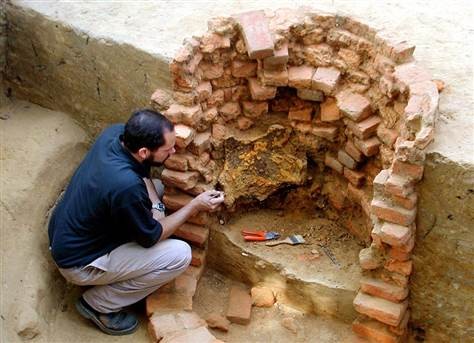Smithfield Well
Introduction
Text-to-speech Audio
Images
Curator Michael Lavin excavates Smithfield Well, ca. 2002-2004. Image courtesy of Association for the Preservation of Virginia Antiquities (reproduced under Fair Use)

Backstory and Context
Text-to-speech Audio
In 2002, archaeologists were excavating outside the western palisade of the former Fort James at Historic Jamestowne. They found a circular brick well which plunged 14 feet below the modern ground level. This well, built during the first decade or two of the Jamestown colony, had become a trash pit and so was rife with examples of the colony's material culture.
The discovered objects provide some details about the colonists and their lives. A pewter flagon bearing the letters P, R, and E might have belonged to settlers Richard and Elizabeth Pierce, who arrived in 1618. Three feet below the surface, archaeologists uncovered a breastplate and other pieces of armor. The iron breastplate had been modified to add a rest for the butt of a gun. A military billhook in the well adds to the evidence of the violence in Jamestown between colonists and Powhatan Indians during these years. Even further into the well were farm tools such as heavy hoes, indicative of the importance of growing tobacco in this period. The artifacts are held in the Nathalie P. & Alan M. Voorhees Archaearium at Historic Jamestowne.
There are theories regarding why the well became a trash pit, which happened around 1624. It is possible that after the Virginia Company lost its charter, or after Virginia became a royal colony, swift changes in leadership may have led to settlers disposing of goods quickly.
Sources
Associated Press. Artifacts drawn from Jamestown well, NBC News. January 5th 2004. Accessed March 20th 2020. http://www.nbcnews.com/id/3882224/ns/technology_and_science-science/t/artifacts-drawn-jamestown-well/.
Jamestown Rediscovery. Smithfield Well, Historic Jamestowne. 2020. Accessed March 20th 2020. https://historicjamestowne.org/archaeology/map-of-discoveries/smithfield-well/.
Association for the Preservation of Virginia Antiquities
